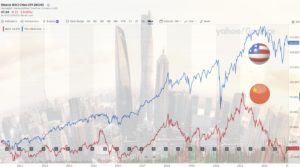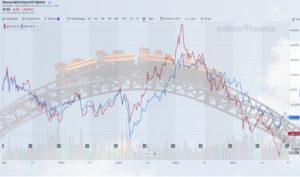China’s stock market isn’t what it used to be – a growth story every investor wanted to be in. Today, China suffers from its own Zero Covid public health policies, and geopolitics, led by the U.S., political risk in Chinese securities – both stocks and bonds – have never been greater. Its growth story is softening, and political risk is rising. This will continue into 2023.
On Dec. 21, South Dakota governor Kristi Noem sent a letter to House and Senate leaders from both parties asking for legislation next year that would restrict or ban state pension funds from investing in Chinese companies. [1]

BlackRock’s iShares MSCI China fund was inaugurated in 2011. Like all investments, timing is everything. But any long term investor who had investments linked to the MSCI China index in a retirement account in 2011 is down by around 32% while an investment in the U.S. is up 164%. Investors are not being paid for the risks they are taking in China.
Investing in China: A Closer Look
In investing, a fiduciary is responsible for both making money and protecting client capital. This is especially true for fund managers tasked with managing retirement accounts, which is how most Americans invest. There is well over $30 trillion in the U.S. retirement market. [2]
Many fund managers say it is their duty to put some of that capital in China because its market is so big. To avoid it would not be prudent.
But as it is also their duty to protect investors from risk, China now represents both financial and geopolitical risks to their clients. That risk is rising, while China investments have not delivered.
The U.S. Government has enabled Americans to invest billions of taxpayer dollars in Chinese Communist Party (CCP) controlled companies via the U.S. Government retirement system, the Thrift Savings Plan (TSP) which is managed by the Federal Retirement Thrift Investment Board (FRTIB). The TSP’s Mutual Fund Window initiative opened on June 1, 2022, allowing investors to use a platform to invest in 5,000 funds, including more than 20 China-only funds; as well as has continued to invest in Chinese companies through the I-Fund of the traditional funds structure of the TSP. To date, no proper due diligence or screening has been performed by the FRTIB regarding which mutual funds will be included in the new TSP platform to ensure that they do not include U.S.-sanctioned or other Chinese corporate “bad actors.”
CPA believes that the only way to protect taxpayers’ and America’s military and civil services’ retirements — both past and present — is to permanently put a stop to any investment of the TSP into Chinese equities. Some companies are on the Entity List for forced labor, like Daqo New Energy, a solar supply chain company. Yet is remains open to all investors.
Is China Worth the Risk?
- The World Bank calls China’s economy “unsustainable”. [3]
- Michael Pettis: “Until the country begins its difficult adjustment, it can continue to grow rapidly only with the piling on of more nonproductive investment, creating more inflated growth.” [4]
- Short-term, consumption is falling because of never-ending public health restrictions. Zero Covid has Wuhan in lockdown again in October/November 2022. Long-term, China’s growth outlook is constrained by demographics, falling productivity, and failed structural reforms of the past decade. With the property market also in distress, it may take several years to close that output gap, even if monetary and fiscal policy is more supportive.
- Imports, driven by domestic economic activity, are lagging behind the boom in exports as Chinese producers scramble for foreign markets to offset the lack of domestic demand.
- The Biden administration continues to pressure China tech, with new restrictions on what U.S. tech companies can sell to Chinese companies. This could extend to biotech next. [5]
- Foreign direct investment into China is deceptive for a variety of reasons [6]:
- China’s FDI includes investment from Hong Kong and Macau – its two special administrative regions – and Taiwan. Hong Kong has long been the single largest source of FDI into mainland China during the past four decades, accounting for over half of the overall value.
- Tax havens of the British Virgin Islands and the Cayman Islands have traditionally ranked high as major investment sources for China. Investments into mainland China from Hong Kong, Singapore and the Caribbean tax havens are not necessarily from the subsidiaries of foreign multinationals putting money to work there but can be from shell companies set up by mainland China businesses.
- Overall FDI into China from other parts of the world fell 19.6% between 2010-20.
- An American Chamber of Commerce in China survey in May found that 51% of respondents have delayed or decreased investments there.
- BlackRock Investment Institute added U.S.-China competition to its list of top 10 geopolitical risks for 2022.
- Europe is considering forced labor provisions like the U.S. Uyghur Forced Labor Prevention law which will make China less attractive. [7]

Here again we can see that China has been a worse investment over a five year period than the emerging markets overall. Emerging markets have been pulled down by China, yet still do better than China despite China’s overweight position in those
funds. Fund managers with a fiduciary responsibility to U.S. government retirement capital should not be invested in China.
China has been a risky bet for retail investors. The country is overweighted in the benchmark MSCI Emerging Markets Index and yet even an investment in a diversified emerging markets fund was better than an investment in China, which has hurt the performance of all emerging market funds. China also notoriously plays the global financial and economic development systems to have it both ways as both a “developed” and a “developing” economy and as a world financial hub while also being an “emerging” market. These inconsistencies are indicative of an increased risk environment with less stability and dramatic swings in growth and risk.
With Washington critical of China technology companies, and banning dozens of companies with capital market sanctions last year, China is a risky investment into a rival nation that no U.S. military retirement fund should be invested in.
_______________________________________________________________________________________________________________________________________
-
The South Dakota Investment Council has sold all of its Chinese investments in its internally managed portfolios. Currently, approximately 1.3% of the state’s total portfolio is invested in China via an emerging markets ETF, which China accounts for roughly a third. “States stand ready to act, and legislation supporting divestments from China would be a great tool to help us do that,” Noem wrote in her letter to Senate and House Majority, Minority Leaders on Dec. 21, 2022.
-
U.S. retirement funds had $37.2 trillion invested in 2021, according to the Investment Company Institute. https://www.ici.org/faqs/faq/401k/faqs_401k
-
World Bank, China Economic Update, June 2022. https://www.worldbank.org/en/country/china/publication/china-economic-update-june-2022
-
“The Only Five Paths China’s Economy Can Follow”, by Michael Pettis, Carnegie Endowment for International Peace. https://carnegieendowment.org/chinafinancialmarkets/87007
-
Expect More China-related Tech Crackdowns, U.S. Official Says,” by Jeanne Whalen, The Washington Post, October 27, 2022. More China export crackdowns might be coming, U.S. official says – The Washington Post
-
See South China Morning Post on this topic. https://www.scmp.com/economy/economic-indicators/article/3181037/how-much-chinas-foreign-direct-investment-and-it-still
-
EU Looks to Follow Tough U.S. Action on Forced Labor,” by Richard Vanderford, WSJ, October 31, 2022. https://www.wsj.com/articles/eu-looks-to-follow-tough-u-s-action-on-forced-labor-11667208602












